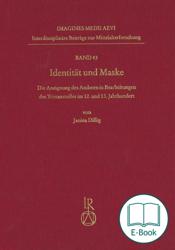This volume concentrates on episodes in Middle High German literature in which identity becomes ambiguous through the using of disguises. In this way, these episodes are not underestimated as droll story elements but are actively used to explain how identity is constructed in medieval literature. It is the aim of this monograph to uncover and analyze the link between identity and disguise and in so doing contribute to a fuller understanding of the different and manifold ways of identity construction in the Middle Ages and to show parallels to modern forms if identity. Subject of the study is the Tristan character who uses disguises continuously due to his illicit love to Isolde and the resulting need for secrecy. This is achieved by not only looking at the ‘Tristan’ of Gottfried of Straßburg but at all Middle High German Tristan narrations of the 12th and 13th century.
The basic prerequisites of identity in the Middle Ages are supposedly already known but loose their significance as soon as identity is concealed, which happens quite often in medieval literature. There are several protagonists who hide their identity either by not naming themselves or by hiding their bodies through a disguise. Therefore, this volume concentrates on episodes in which identity becomes ambiguous thorough the use of disguises. Through this focus, the interdependencies between identity and disguises are explored in depth. In this way, these episodes are not underestimated as droll story elements but are actively used to explain how identity is constructed in medieval literature. It is the aim of this monograph to uncover and analyze the link between identity and disguise and in so doing contribute to a fuller understanding of the different and manifold ways of identity construction in the Middle Ages and to show parallels to modern forms of identity.
Subject of the study is the Tristan character who uses disguises in most all Middle High German adaptations due to his illicit love to Isolde and the resulting need for secrecy. Tristan can be understood as the prime example of the options and uses of disguises in the Middle Ages and medieval literature.
By concentrating on the Tristan character, the research in this book is part of a bigger scientific discussion on identity in the Tristan stories but fundamentally differs from other works through its focus on Tristan’s disguises such as a pilgrim, a leper or a fool. In addition, this work distinguishes itself from similar works by not only looking at the ‘Tristan’ of Gottfried of Straßburg but including the entire Middle High German Tristan tradition starting from Eilhart of Oberg until the end of the 13th century. As such, the continuations of Ulrich of Türheim and Heinrich von Freiberg and especially the poem ‘Tristan as a monk’ are analyzed to the same degree as Gottfried’s ‘Tristan’. This makes it possible to also look at the differences between these Tristan narrations and their significance for the construction of the identity of a literary character such as Tristan.
„Die Arbeit (zugl. Univ. Bamberg, Diss., 2014) ist der Frage nach der Identität der Tristanfigur in den deutschsprachigen Tristanbearbeitungen sowie den Möglichkeiten, diese durch Maskierung(en) zu verschleiern, gewidmet. (...) Aufbauend auf einem überzeugenden Theoriekapitel spürt sie den Maskierungen und der damit einhergehenden Identitätsbewahrung, -verschleierung aber auch -aufgabe der Tristanfigur in den Texten Eilharts, Gottfrieds, Ulrichs und Heinrichs sowie in Tristan als Mönch nach. (...) Besonders überzeugend ist die Argumentation, wo Dillig nachweist, dass die in der Forschung etablierte Negativdeutung der Verkleidungen der Tristanfigur in den Wiederkehrabenteuern nicht haltbar ist.“
Von Birgit Zacke
In: Germanistik 2020 · BAND 61 · HEFT 1-2, S. 210-211
Kurzvita Dr. Janina Dillig
Geboren 1982 in Bamberg
1998-2000 Teilnehmerin an den Comenius-Projekten Jüdische Kultur in Europa und Exilliteraten in Weimar (D), Avellino (I), Montpellier (F) und Girona (ES)
2002 Abitur am Dientzenhofer Gymnasium Bamberg
2002-2009 Studium der Fächer Germanistik, Philosophie und Politikwissenschaft an der Otto-Friedrich-Universität Bamberg. Im akademischen Jahr 2004/05 Stipendiatin des Deutsch-Amerikanischen Verbandes an der University of the South, Sewanee, TN (USA).
2009-2014 Promotionsstudium am Lehrstuhl für Deutsche Philologie des Mittelalters, dabei von 2009-2012 Stipendiatin im DFG-Graduiertenkolleg ‚Generationenbewusstsein und Generationenkonflikte in Antike und Mittelalter‘.
2015-2016 Mitarbeiterin Qualitätsmanagement, Universität Bamberg
seit 2009 Lehrbeauftragte am Lehrstuhl für Deutsche Philologie des Mittelalters an der Universität Bamberg
seit 2016 Referentin für Frauenförderung im Frauenbüro an der Universität Bamberg
This series, which will comprise doctoral and professorial dissertations and other monographs as well as collective volumes, aims at highlighting and promoting interdisciplinarity in Medieval Studies even more than is currently the case. Works from all branches of Medieval Studies will be accepted, provided they emphasise the aspect of interdisciplinarity, i.e. they attempt to transgress the boundaries of any single subject.


 Preface
Preface